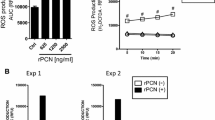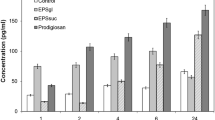Abstract
Chromoblastomycosis is a chronic, suppurative and granulomatous mycosis whose main etiologic agent is the fungus Fonsecaea pedrosoi. The severity of chromoblastomycosis clinical manifestations correlates with the Th1 or Th2 immune response, and an efficient cellular immune response depends on the interaction between immune cells and the cell wall of the fungi, which is able to promote this activation. The objective of this study was to analyze the influence of cell wall fractions of Fonsecaea pedrosoi on the activation of peritoneal phagocytes obtained from mice. Our results revealed that after 4 h of inoculation with fungal cell wall components, there was a cell migration predominantly comprised of neutrophils followed, after 72 h, by migration of the macrophages. After 4 h, the F2 fraction caused increased production of nitric oxide in phagocytes, but this effect was not observed in the phagocytes after 72 h. The F1 fraction stimulated production of IL-12 in cells that migrated after 72 h, while the inactivated fungus and the F2 fraction led to production of IL-10. The F2 fraction decreased the rate of phagocytosis and increased the production of IL-10. Our results suggest that the F2 fraction and its components caused an important disruption of microbicidal mechanisms negatively modulating the immune response and favoring the persistence of the fungus.







Similar content being viewed by others
References
Rajeev S, Clifon G, Watson DM. Fonsecaea pedrosoi skin infection in a dog. J Vet Diagn Invest. 2008;20:379–81.
McGinnis MR. Chromoblastomycosis and phaeohyphomycosis. New concepts, diagnosis and mycology. J Am Acad Dermat. 1983;8:1–6.
Salgado CG, Silva JP, Diniz JAP, et al. Isolation of Fonsecaea pedrosoi from thorns of Mimosa pudica, a probable natural source of chromoblastomycosis. Rev Inst Med Trop Sao Paulo. 2004;46:33–6.
Franzen AJ, Cunha MML, Miranda K, et al. Ultrastructural characterization of melanosomes of the human pathogenic fungus Fonsecaea pedrosoi. J Struct Biol. 2008;162:75–84.
Santos ALS, Palmeira VF, Rozental S, et al. Biology and pathogenesis of Fonsecaea pedrosoi, the major etiologic agent of chromoblastomycosis. FEMS. 2007;31:570–91.
Silva CL, Fazioli RA. A Paracoccidioides brasiliensis having granuloma-inducing, toxic and macrophage stimulating activity. J Gen Microbiol. 1985;131:1497–501.
Bocca AL, Brito PPMS, Figueiredo F, Tosta CE. Inhibition of nitric oxide production by macrophages in chromoblastomycosis: a role for Fonsecaea pedrosoi melanin. Mycopathologia. 2006;161:195–203.
Uribe F, Zuluaga AI, Leon W, Restrepo A. Histopathology of chromoblastomycosis. Mycopathologia. 1989;105:1–6.
Farbiarz SR, de Carvalho TV, Alviano C, de Souza W. Inhibitory effect of melanin on the interaction of Fonsecaea pedrosoi with mammalian cells in vitro. J Med Vet Mycol. 1992;30:265–73.
Rozental S, Alviano CS, de Souza W. The in vitro susceptibility of Fonsecaea pedrosoi to activated macrophages. Mycopathologia. 1994;126:85–91.
Rozental S, Alviano CS, de Souza W. Fine structure and cytochemical study of the interaction between Fonsecaea pedrosoi and rat polymorphonuclear leukocyte. J Med Vet Mycol. 1996;34:323–30.
Gimenes VMF, Souza MG, Ferreira KS, et al. Cytokines and lymphocyte proliferation in patients with different clinical forms of chromoblastomycosis. Microbes Infect. 2005;7:708–13.
D’Ávila SCGP, Pagliari C, Duarte MIS. The cell-mediated immune reaction in the cutaneous lesion of Chromoblastomycosis and their correlation with different clinical forms of the disease. Mycopathologia. 2002;156:51–60.
Gimenes VMF, Criado PR, Martins JEC, Almeida SR. Cellular immune response of patients with chromoblastomycosis undergoing antifungal therapy. Mycopathologia. 2006;162:97–101.
Silva CL, Fazioli RA. Role of the fungal cell wall in the granulomatous response of mice to the agents of chromomycosis. J Med Microbiol. 1985;20:299–305.
Silva CL, Fazioli RA. A Paracoccidioides brasiliensis having granuloma-inducing, toxic and macrophage stimulating activity. J Gen Microbiol. 1985;131:1497–501.
San-Blas G. The cell wall of fungal human pathogens: its possible role in host-parasite relationship. Mycopathologia. 1982;79:159–84.
Szaniszlo PJ, Cooper BH, Voges HS. Granulomatous compositions of the hyphal walls of three chromomycosis agents. Sabouraudia. 1972;10:94–102.
Zaccharias D, Ueda A, Moscardi-Bacchi M, et al. A comparative histopathological, immunological, and biochemical study of experimental intravenous paracoccidioidomycosis induced in mice by three Paracoccidioides brasiliensis isolates. J Med Vet Mycol. 1986;24:445–54.
Wang Y, Aisen P, Casadevall A. Cryptococcus neoformans melanin and virulence: mechanism of action. Infect Immun. 1995;63:3131–6.
Taborda CP, Silva MB, Nosanchuk JD, Travassos LR. Melanin as a virulence factor of Paracoccidioides brasiliensis and other dimorphic pathogenic fungi: a minireview. Mycopathologia. 2008;162:331–9.
Jacobson ER. Pathogenic roles for fungal Melanins. Clin Microbiol Rev. 2000;13:708–17.
Kanetsuna F, Carbonell LM, Azuma I, Yamamura Y. Biochemical studies on thermal dimorphism of Paracoccidioides brasiliensis. J Bacteriol. 1972;110:208–18.
Alviano CS, Farbiarz SR, Souza W, et al. Characterization of Fonsecaea pedrosoi melanin. J Gen Microbiol. 1991;137:837–44.
Green LC, Wagner DA, Ruiz de Luzureaga K, et al. Nitrate biosynthesis in man. Proc Natl Acad Sci USA. 1981;78:7764–80.
Allendoerfer R, Deepe GS Jr. Intrapulmonary response to Histoplasma capsulatum in gamma interferon knockout mice. Infect Immun. 1997;65:2564–70.
Wozniak KL, Ravi S, Macias S, et al. Insights into the mechanisms of protective immunity against Cryptococcus neoformans infection using a mouse model of pulmonary cruptococcosis. PLoS One. 2009;4(9):e6854.
Mamoni RL, Blotta MH. Kinetics of cytokines and chemokines gene expression distinguishes Paracoccidoides brasiliensis infection from disease. Cytokine. 2005;32:20–9.
Romano CC, Mendes-Giannini MJ, Duarte AJ, Benard G. The role of interleukin 10 in the differential expression of interleukin-12p70 and its beta2 receptor on patients with active or treated paracoccidioidomycosis and healthy infected subjects. Clin Immunol. 2005;14:86–94.
Naundorf S, Schröder M, Höflich C, et al. IL-10 interferes directly with TCR-induced IFN-gamma but not IL-17 production in memory T cells. Eur J Immunol. 2009;39:1435–46.
Stevens DA. Th1/Th2 in aspergillosis. Med Mycol. 2006;1:229–35.
Altamura M, Casale D, Pepe M, Tafaro A. Immune responses to fungal infections and therapeutic implications. Curr Drug Targets Immune Endocr Metabol Disord. 2001;1:189–97.
Teixeira de Sousa MG, Ghosn EEB, Almeida SR. Absence of CD4+ T cells impairs host defence of mice infected with Fonsecaea pedrosoi. Scand J Immunol. 2006;64:595–600.
Wuthrich M, Filutowicz HI, Warner T, et al. Vaccine immunity to pathogenic fungi overcomes the requirements for CD4 help in exogenous antigen presentation to CD8+ T cells: implications for vaccine development in immune-deficient hosts. J Exp Med. 2003;197:1405–16.
Pitarch A, Nombela C, Gil C. Collection of proteins secreted from yeast protoplast in active cell wall regeneration. Methods Mol Biol. 2008;425:241–63.
Kanetsuna F, Carbonell LM. Cell wall glucan of the yeast and mycelial forms of Paracoccidioides brasiliensis. J Bacteriol. 1970;101:675–80.
Ishida-Okawara A, Nagi-Miura N, Oharaseki T, et al. Neutrophil activation and arteritis induced by C. Albicans water-soluble mannoprotein-β-glucan complex (CAWS). Exp Mol Pathol. 2007;82:220–6.
Sato T, Iwabuchi K, Nagaoka I, et al. Induction of human neutrophil chemotaxis by Candida albicans-derived beta-1, 6-long glycoside side-chain-branched beta-glucan. J Leukoc Biol. 2006;80:204–11.
Obayashi T, Yoshida M, Mari T, et al. Plasma (1-3) β-glucan measurement in diagnosis of invasive deep mycosis and fungal febrile episodes. Lancet. 1995;345:17–20.
Medeiros AI, Malheiros A, Jose PJ, et al. Differential release of MIP-1 alpha and eotaxin during infection of mice by Histoplasma capsulatum or inoculation of beta-glucan. Inflamm Res. 2004;53:351–4.
Rappleye CA, Eissenberg LG, Goldman WE. Histoplasma capsulatum α-(1-3)-glucan blocks innate immune recognition by the β-glucan receptor. Proc Natl Acad Sci USA. 2007;4:1366–70.
Gómez BL, Nosanchuk JD. Melanin and fungi. Curr Opin Infect Dis. 2003;16:91–6.
Acknowledgments
We would like to thank Professors Alice Melo Ribeiro and Bruno Cobucci Salles for critical discussion and review of the manuscript. This work was supported by a grant from Conselho Nacional de Desenvolvimento Científico e Tecnológico (CNPq) and Fundação de Apoio à Pesquisa do Distrito Federal (FAP-DF).
Author information
Authors and Affiliations
Corresponding author
Rights and permissions
About this article
Cite this article
de Medeiros Nóbrega, Y.K., Lozano, V.F., de Araújo, T.S. et al. The Cell Wall Fraction from Fonsecaea pedrosoi Stimulates Production of Different Profiles of Cytokines and Nitric Oxide by Murine Peritoneal Cells In Vitro. Mycopathologia 170, 89–98 (2010). https://doi.org/10.1007/s11046-010-9303-8
Received:
Accepted:
Published:
Issue Date:
DOI: https://doi.org/10.1007/s11046-010-9303-8




